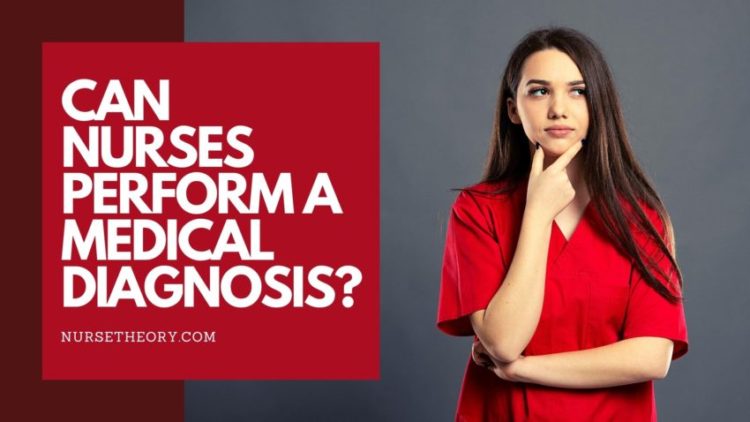
Only a select group of specialized nurses can diagnose a patient’s condition.
Most nurses don’t have the authority or scope of practice to perform a diagnosis.
For example, CNAs, LPNs, and registered nurses do not diagnose their patient’s conditions.
Moreover, they don’t prescribe medications, perform invasive surgical procedures (independently) or act as primary care providers.
Accordingly, these nurses must consult a qualified medical professional to make a medical diagnosis.
Registered nurses assess and prioritize patients’ medical conditions, create nursing diagnoses, and develop care plans to ensure optimal patient treatment/outcomes.
Some advanced practice registered nurses (APRNs) can diagnose a patient’s medical condition.
APRNs include nurse practitioners, clinical nurse specialists, certified nurse-midwife, and certified registered nurse anesthetists.
These medical professionals have extensive post-graduate education and training to diagnose and treat various patient conditions.
Nurse practitioners work in diverse specializations and frequently diagnose their patient’s medical conditions.
Specializations Include:
- Family nurse practitioner
- Adult-gerontology acute care nurse practitioner
- Adult-gerontology primary care nurse practitioner
- Neonatal nurse practitioner
- Pediatric nurse practitioners (acute or primary
- Psychiatric mental health nurse practitioner
- Women’s health nurse practitioner
Some nurse practitioners also prescribe medications and act as primary care providers, which entails performing diagnoses of patients’ conditions.
They’ve obtained significant training and specialization to understand their patient’s conditions.
As a result, diagnosing patients fall within their scope of practice.
Healthcare Professionals Who Perform Diagnosis
- Nurse practitioners
- physicians
- physician assistants
- healthcare scientist
- physiotherapists
- dentists
- podiatrists
- optometrists
- Surgeons
- Physicians
Finally, some individuals confuse a medical diagnosis with a nursing diagnosis.
Therefore, I’ll explain what a nursing diagnosis is next to understand the topic better.
What About Nursing Diagnosis?
A nursing diagnosis is distinct from a medical diagnosis.
According to NANDA International, a medical diagnosis is a concept that defines a disease’s process or injury.
A medical diagnosis defines the illness, disease, or condition:
- Heart attack
- Stroke
- CVA
- Pneumonia
- Amputation
- Type 2 Diabetes
A nursing diagnosis is a clinical judgment of an individual, family, or communities responses to potential or actual health problems/life processes.
A nursing diagnosis explains the condition’s effects:
- Fatigue
- Shortness of breath
- Impaired verbal communication
- Self-care deficit: Impaired behaviors
- Ineffective airway clearance
It also provides nurses with medical priorities, intervention plans, evaluation processes, and specific outcomes.
As a result, a medical diagnosis defines the medical condition while the nursing process provides a holistic management plan.
The Purpose of a Nursing Diagnosis
- Identify nursing priorities and interventions
- Formulate anticipated patient outcomes
- Implement a valid evaluation process to determine whether a care plan is effective
- Utilize analytical thinking and evaluative reasoning to improve care plans if needed
- Present a universal foundation of communication for nurses
- Provide students with problem-solving and critical thinking skills
A nursing diagnosis is a component of the nursing process designed to ensure appropriate steps to provide optimal patient care.
There are five stages to the nursing process, which nurses commonly refer to as ADPIE.
ADPIE stands for assessment, diagnosis, planning, implementation, and evaluation.
First, nurses assess the situation (assessment) by collecting data to develop a diagnosis/clinical judgment (diagnosis).
Next, nurses develop SMART goals, interventions, and the care plan (planning) and execute them to improve patient outcomes (implementation).
Finally, they evaluate the implemented process, make necessary changes and reevaluate it to ensure a smooth process (evaluation).
Understanding Medical Diagnosis
A medical diagnosis is formed by carefully gathering and analyzing patient data/information.
Essentially, medical professionals assess the patient’s clinical history and interview them/family members to understand their ailment better.
They also perform physical exams, conduct diagnostic/blood tests, and direct patient referrals/consultations to gather information.
Finally, all of the information is analyzed, discussed, and reviewed before making a medical diagnosis.
It’s important to mention that a patient’s symptoms do not define their illness, disease, or condition.
Various illnesses, diseases, and conditions produce similar symptoms making it difficult to determine a condition by symptoms alone.
As a result, making a diagnosis solely from a patient’s symptoms is very dangerous since treatments can have adverse effects.
Before forming a medical diagnosis, medical professionals must consider all aspects (clinical history, physical examinations, diagnostic testing, referrals/consultations, interviews).
The Diagnostic Process:
- Interview the patient/family members and review their clinical history
- Perform physical exam(s)
- Generate a provisional and differential diagnosis
- Conduct diagnostic/blood testing
- Send the patient for referral or consultation
- Analyze, discuss and review all collected data
- Reach a final diagnosis
A medical diagnosis is not a treatment, intervention, or care plan.
As a result, it does not provide actions to improve an individual’s medical condition or outcome.
Instead, a medical diagnosis determines a patient’s illness, injury, or condition based on careful data gathering, analysis, and discussion.
It identifies the particular ailment(s) to develop and administer a proper treatment plan, medication, and recovery process.
Should Nurses Perform Medical Diagnosis?
Some nurses can diagnose a patient’s condition, as previously mentioned.
However, extensive education and specialized training are required to ensure an accurate diagnosis.
As a result, nurse practitioners and some advanced practice registered nurses can diagnose their patient’s conditions.
Diagnosing medical conditions often requires physical examinations, ordering lab/diagnostic tests, reviewing test results, and consulting other qualified medical professionals.
Finally, it must fall within a nurse’s scope of practice to provide a medical diagnosis.
All medical professionals, including physicians, psychologists, and practitioners, must practice within their authorized/legal competencies and limitations.
Essentially, their career specialty, education, training, and state/government laws determine their scope of practice.
Nevertheless, nurses who do not diagnose medical conditions still form complementary nursing diagnoses to improve patient outcomes.
Nursing diagnoses are integral to healthcare and ensure they follow proper processes to manage patient well-being and treatment.
Nurses unsure whether performing specific tasks is wise must review their institution’s policies and procedures on admission.
It provides helpful information on facility procedures to ensure you understand their systems and expectations.